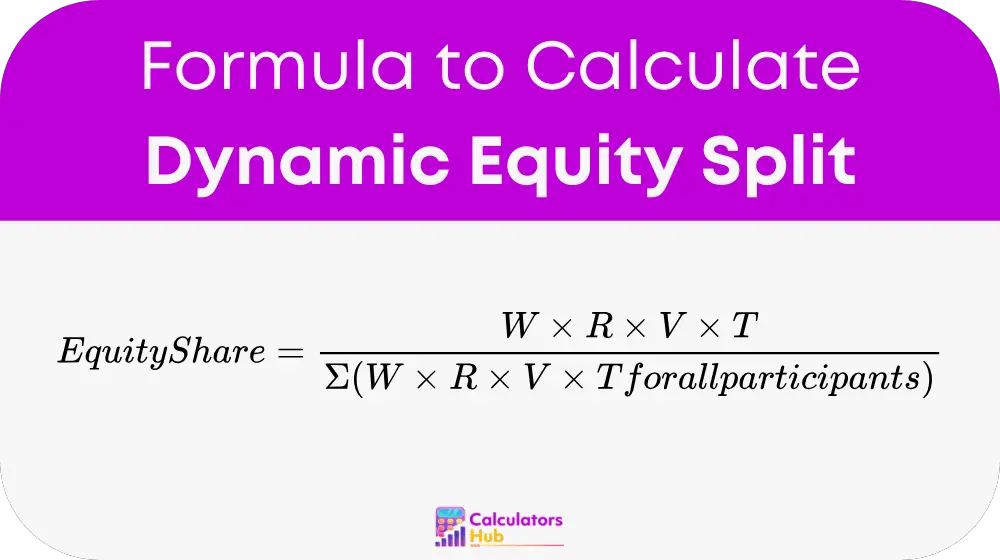The Dynamic Equity Split Calculator helps divide ownership in a business or project fairly among the people involved. Instead of just splitting equity—like stocks or shares—equally, it looks at what each person brings to the table. This tool falls under the category of business calculators, making it perfect for startups, partners, or teams working together. It considers things like time, effort, money, and risk to give everyone a fair piece of the pie.
Why is this useful? When you start a company or project, not everyone contributes the same way. One person might work full-time, another might put in cash, and someone else might take a big risk. This calculator makes sure the equity split reflects those differences. It’s great for real-life decisions, like setting up a fair partnership, avoiding arguments, or keeping everyone motivated. Plus, it’s reliable for important financial choices—like ensuring your business starts on solid ground. Ready to see how it works? Let’s jump into the formula next.
Formula for Dynamic Equity Split
The formula for calculating each person’s equity share is:

Where:
- W = Weight (how important their contribution is, like a score from 1-10)
- R = Risk factor (how much risk they take, like 1 for low, 3 for high)
- V = Value contribution (money, skills, or resources they add)
- T = Time commitment (hours or months they put in)
- Σ = Sum of all participants’ weighted contributions
For each participant:
Final Equity Percentage = Equity Share × 100%
This formula comes from business fairness models, like those used in startups. Each person gets a score based on their input, and then it’s divided by the total to find their share. Multiply by 100 to turn it into a percentage. It sounds like a lot, but it’s just a way to weigh everyone’s effort. Now, let’s make it simpler with a table.
Quick Reference Table for Equity Splits
Why calculate from scratch every time? This table shows sample equity splits for common scenarios. It assumes three people with different contributions.
| Participant | Weight (W) | Risk (R) | Value (V, $) | Time (T, hrs) | Equity (%) |
|---|---|---|---|---|---|
| Person A | 5 | 1 | 5,000 | 100 | 14.29 |
| Person B | 8 | 2 | 10,000 | 200 | 57.14 |
| Person C | 3 | 3 | 2,000 | 50 | 28.57 |
How to Use the Table
- Look at each person’s contribution factors.
- Check their equity percentage.
- Use it to get a quick idea of fair splits.
This table helps with searches like “fair equity split for startup team.” For your own numbers, use the formula. Next, let’s try an example.
Example of Dynamic Equity Split Calculator
Suppose three people start a business:
- Person A: Weight = 4, Risk = 1, Value = $2,000, Time = 50 hours
- Person B: Weight = 6, Risk = 2, Value = $5,000, Time = 100 hours
- Person C: Weight = 5, Risk = 3, Value = $3,000, Time = 80 hours
You want their equity percentages. Here’s how:
- Calculate each person’s score:
- A: 4 × 1 × 2,000 × 50 = 400,000
- B: 6 × 2 × 5,000 × 100 = 6,000,000
- C: 5 × 3 × 3,000 × 80 = 3,600,000
- Add them up:
Total = 400,000 + 6,000,000 + 3,600,000 = 10,000,000 - Find equity shares:
- A: (400,000 / 10,000,000) × 100 = 4%
- B: (6,000,000 / 10,000,000) × 100 = 60%
- C: (3,600,000 / 10,000,000) × 100 = 36%
So, Person A gets 4%, Person B gets 60%, and Person C gets 36%. This reflects their different contributions fairly.
Most Common FAQs
A dynamic equity split looks at what each person actually does—like time, money, or risk—instead of just giving everyone the same share. It keeps things fair, especially when contributions aren’t equal, and helps avoid fights over ownership later.
Weight and risk depend on your team’s agreement. Weight scores how key their role is—like 5 for average, 10 for critical. Risk is about what they’re putting on the line—like 1 for no risk, 3 if they quit a job. Talk it out with your team to set fair values.
Yes, you can update it as contributions change—like if someone works more or adds cash later. Recalculate with new numbers to keep the split fair as the project grows or shifts.